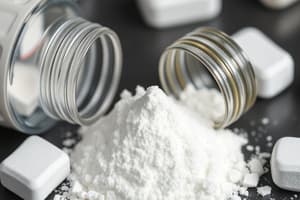Podcast
Questions and Answers
What is the purpose of rinsing the pipette with HCl before use?
What is the purpose of rinsing the pipette with HCl before use?
- To calibrate the pipette for accurate measurements
- To prevent color change in the bromophenol indicator
- To remove any contaminants from previous solutions (correct)
- To ensure a precise volume of NaOH is transferred
Why is it important to boil the solutions before adding the bromophenol indicator?
Why is it important to boil the solutions before adding the bromophenol indicator?
- To evaporate excess water from the solution
- To eliminate dissolved CO2 which can affect pH (correct)
- To speed up the titration process
- To concentrate the antacid samples
What indicates the endpoint of the titration in this procedure?
What indicates the endpoint of the titration in this procedure?
- A distinct color change of the bromophenol indicator (correct)
- The reaction has reached a boiling point
- The volume of NaOH used surpasses 50.00 mL
- The complete disappearance of the antacid sample
What is the significance of back titration in this antacid analysis procedure?
What is the significance of back titration in this antacid analysis procedure?
What measurement is critical to calculate the moles of bases present in the antacid?
What measurement is critical to calculate the moles of bases present in the antacid?
Flashcards are hidden until you start studying
Study Notes
Antacid Analysis Procedure
-
Sample Preparation:
- Three conical flasks are prepared, labeled as 1, 2, and 3.
- Approximately 0.2g of pulverized antacid is weighed and added to each flask.
- 25.00 mL of HCl solution is added to each flask using a pipette.
- The solutions are boiled to remove dissolved CO2.
- The solutions are cooled and 5 drops of bromophenol indicator are added.
- The color of the indicator changes depending on the pH level.
- The indicator is yellow in acidic solutions and blue in basic solutions.
- This is a back titration - antacid reacts with HCl, and excess HCl is neutralized with NaOH.
-
Titration:
- A buret is filled with standardized NaOH solution.
- The initial buret reading is recorded.
- The antacid sample is titrated with NaOH solution until the solution turns blue.
- The final buret reading is recorded.
- The procedure is repeated for flasks 2 and 3.
-
Calculation:
- The moles of NaOH used in titration can be calculated from the initial and final buret readings and molar concentration of NaOH.
- The moles of HCl neutralized by the antacid can be calculated from the moles of NaOH used.
- The moles of base present in the antacid can be calculated from the moles of HCl neutralized.
- The moles of base per gram of antacid can be calculated by dividing the moles of base by the mass of antacid used.
-
Important Considerations:
- Accuracy: The results of the analysis are only as accurate as the measurements taken.
- Indirect Measurement: This is an indirect measurement method because the amount of antacid is determined by measuring the amount of acid that it neutralizes.
- Complex Samples: Antacids contain various ingredients, making analysis complex.
- Quantitative Analysis: This is a quantitative analysis method because it measures the amount of antacid present.
- Precipitation Reactions: Some antacids may form precipitates with HCl, making the analysis more complex.
Studying That Suits You
Use AI to generate personalized quizzes and flashcards to suit your learning preferences.




